Richard Lester’s Musketeers (1973-74): Criterion Blu-ray review
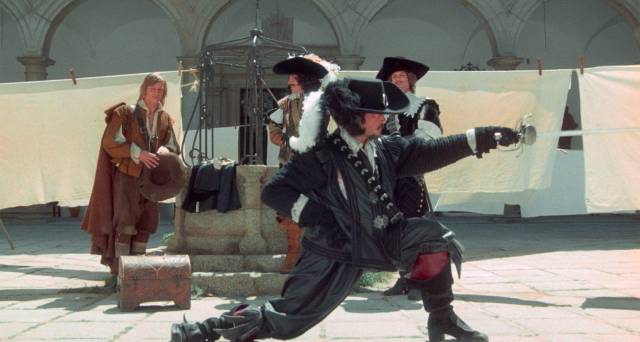
Richard Lester, born in America and transplanted to England in the mid-’50s, had a huge impact on British film in the 1960s when he introduced a radical style – influenced by the New Wave – into comedy with his third feature, A Hard Day’s Night (1964). That film, which both reflected and mocked the celebrity of The Beatles, seemed like something entirely new, a potent mix of music and slapstick delivered at a frantic pace. Visually and verbally anarchic, it helped to create the public personae of the Fab Four and consolidated their status as the most popular musicians in the world.
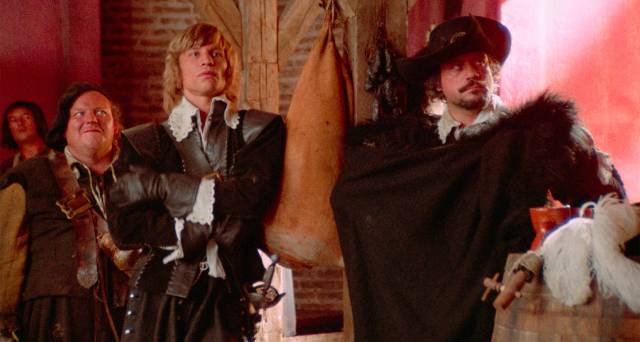
This was followed by the equally anarchic The Knack … and How to Get It (1965) and Help! (also 1965), a second outing with The Beatles which, although commercially successful, failed to recapture the spirit of A Hard Day’s Night because rather than being rooted in the band’s actual lives it attempted to turn John, Paul, George and Ringo into characters in a plot in which an Eastern cult targets Ringo for a human sacrifice leading to an international chase. After this, although Lester continued to apply his radical style to several different genres – an adaptation of the hit stage musical A Funny Thing Happened on the Way to the Forum (1966), the anti-war satire How I Won the War (1967), the contemporary romance Petulia (1968), and the satirical post-apocalyptic comedy The Bed-Sitting Room (1969), all of which received mixed, frequently negative reviews and less than stellar box office success – by the end of the decade he essentially withdrew from filmmaking.
Lured back a few years later by producers Alexander, Michael, and Ilya Salkind, he seemed to have remade himself as a more conventional, more mainstream director. This proved to be a savvy move from a commercial, if not necessarily a creative, point of view. If the dozen features he made between 1973 and 1989 were mostly box office successes, none of them could match the ’60s movies in their anarchic invention. Few boundaries were stretched, but most of these movies were effective entertainments.
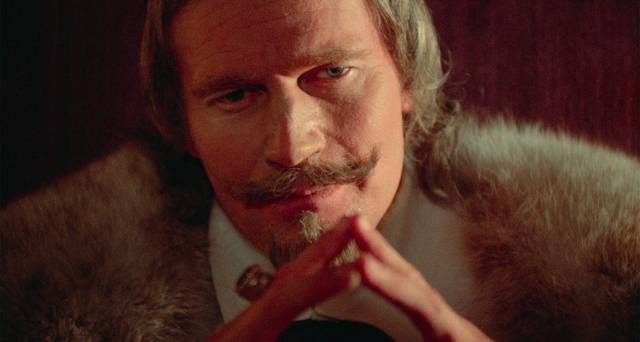
Watching The Three Musketeers: The Queen’s Diamonds (1973) and The Four Musketeers: The Revenge of Milady (1974) again after many years, I found my interest piqued less by Lester’s approach to the familiar material than by other tangential factors. For instance, I was struck by the fact that this adventure story was set in the same world as Ken Russell’s The Devils (1971), made a couple of years earlier. There are several striking links between these very different films besides the fact that the story of Urbain Grandier and Cardinal Richelieu’s attack on the independence of Loudun took place just a few years after the events of Dumas’ novel; most strikingly, both works were photographed by David Watkin, who provides a visual unity despite the tonal differences between the films. Both films clearly exist in the same historical period and share the politics and religious machinations of the time – much of The Four Musketeers is concerned with Richelieu’s assault on the Protestant walled city of La Rochelle, as events in The Devils revolved around the Cardinal’s assault on the walled city of Loudun, where Huguenots and Catholics lived in relative harmony.
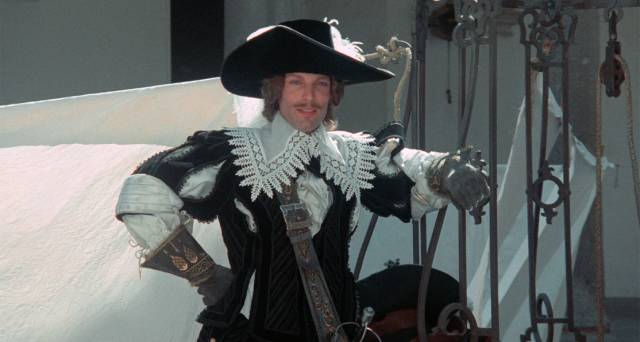
In addition, there’s the presence of Oliver Reed as Athos just two years after giving his greatest performance as Grandier, and also Michael Gothard, the inquisitor Father Barre in Russell’s film, appearing here as Felton, the eventually treacherous right-hand man of the Duke of Buckingham.
The obvious difference between these films is the tone. The gravity of the politics in Lester’s diptych is in conflict with the slapstick approach to the characters and plentiful action, a tone which becomes increasingly jarring, particularly in The Four Musketeers, as things grow darker and death becomes more real and consequential. This tone derives to a great degree from the script by George MacDonald Fraser, who had already published the first three novels in his long-running series about the cowardly cad Harry Flashman who found himself involved in many of the major events of the 19th Century involving the wars and politics of the British Empire. Fraser casts the Musketeers in something of the same mould, as lovable scoundrels caught up in the plans of more powerful people, sometimes intentionally but just as likely inadvertently derailing those plans.
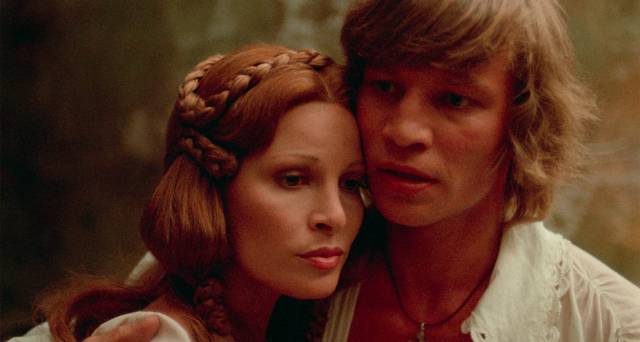
In The Three Musketeers, those plans involve Richelieu (Charlton Heston) scheming to gain power over a weak King Louis XIII (Jean-Pierre Cassel, slightly less foppish than Graham Armitage’s portrayal in The Devils) by discrediting Queen Anna (Geraldine Chaplin), who is involved in a less-than-secret affair with British Prime Minister the Duke of Buckingham (Simon Ward). The plan involves sending Milady De Winter (Faye Dunaway) to England to steal some jewels which Louis had given to Anna, who in turn gave them to Buckingham, thus exposing the affair. The Musketeers, loyal to the Queen, race to prevent her disgrace, while fighting off the Cardinal’s guards under the ruthless Rochefort (Christopher Lee). Along the way, there are numerous swordfights and ambushes – and here’s where Lester’s approach diverges from traditional Hollywood swashbucklers; not only are the fights physically gruelling, they involve all manner of “dirty” tactics, such as hitting an opponent in the head with a rock and, more frequently, a forceful kick to the crotch. Rather than elegantly choreographed duets with rapiers, these fights seem more real and dangerous (with every actor sustaining injuries of some kind during the shoot).
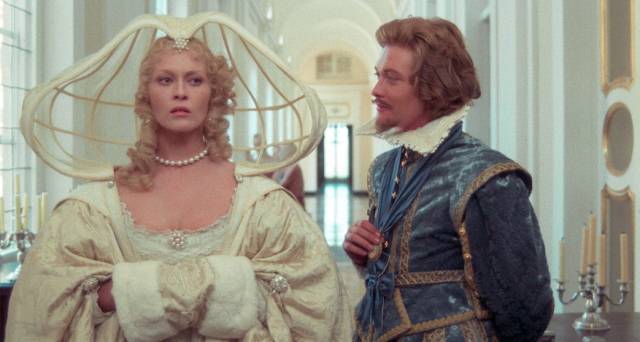
Part one ends with D’Artagnan (Michael York) earning his position in the Musketeers, which is exactly where The Four Musketeers picks up. Now Richelieu is besieging La Rochelle, while Buckingham is preparing to send forces to protect the city. The Cardinal sends Milady to England to either dissuade him or, failing that, kill him. Meanwhile efforts to discredit the Queen continue, with her dressmaker Constance (Raquel Welch), who’s also D’Artagnan’s lover, kidnapped and imprisoned. In parallel, Milady is imprisoned in the Tower of London, where she feigns Christian piety to seduce Felton and turn him against Buckingham. The two women eventually intersect in a convent, where the comic tone all but disappears with a shocking and unexpected act of violence.

Shot in Spain, where costs were relatively low and the range of locations provided excellent production values, both films look impressive with a strong sense of period and dramatic scope – the latter in some tension with the somewhat lowbrow comic tone (we see a lot of cleavage and there are many blows to characters’ heads). The Salkinds managed to gather together an impressive array of actors, whose disparate styles are somehow held together by Lester – ranging from Charlton Heston’s old Hollywood gravitas as Richelieu to the anarchic comedy of Spike Milligan (as Constance’s clueless innkeeper husband) and Roy Kinnear as D’Artagnan’s hapless servant Planchet. Oliver Reed, Richard Chamberlain and Frank Finlay play the Musketeers as a mix of the Marx Brothers and the Three Stooges, while Michael York’s wide-eyed naivete as something of a country bumpkin is occasionally irritating. Raquel Welch is charming as Constance, while Faye Dunaway plays Milady as a cold-hearted femme fatale.
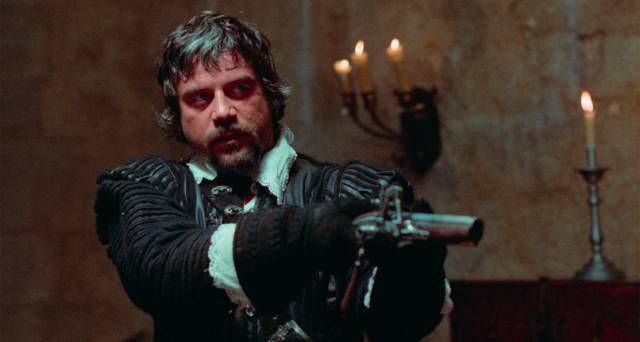
In addition to the films’ unexpected connections with The Devils, it seems quite likely that Lester’s swashbucklers had some influence on Terry Gilliam, in particular on The Adventures of Baron Munchausen (1988), which shares the irreverent tone as well as the visual scope of the Musketeers movies.
If the Musketeer films seemed like a strange change of direction from the contemporary films of the ’60s, they obviously suited Lester since he quickly followed them with Royal Flash (1975), based on George MacDonald Fraser’s second Flashman novel, and Robin and Marian (1976), James Goldman’s elegiac revision of Robin Hood … which along with A Hard Day’s Night is Lester’s finest work. Then a few years later, he made the underrated romantic adventure Cuba (1979) as well as Superman II (1980), which he took over from Richard Donner, and Superman III (1983), before an ill-fated attempt to revisit Alexandre Dumas with The Return of the Musketeers (1979), which failed to recapture the qualities which had made the original two films such a success. (This was Lester’s final feature, perhaps in part because of the death of Roy Kinnear on set, when he fell from a horse.)
*
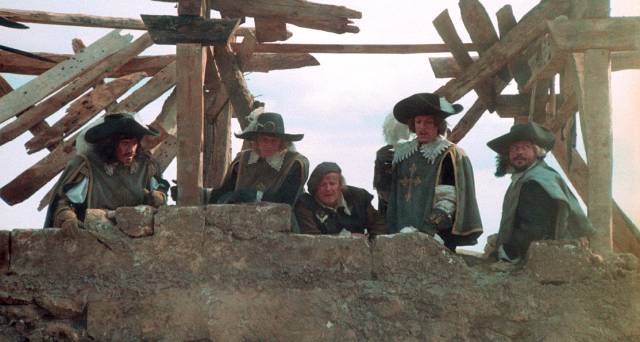
When the films were originally released there was some controversy, which may seem strange today when so many franchise movies are split in two to maximize profits. Written as one long film to be released with an intermission, as so many big productions had been in the ’50s and ’60s, Lester and his team were faced with a seemingly insurmountable difficulty when, having wrapped shooting in September 1973, they were told by the Salkinds that a premiere was scheduled in Paris in early December. How could editing, sound mixing, and post-production lab work be completed on a three-and-a-half-hour movie in two months? The solution was to complete the first half and put off the second half to a later date. The risk, of course, would be that a disappointing box office showing would make it less feasible to complete the second half. In the event, The Three Musketeers was a hit and The Four Musketeers was released ten months later (a month after Lester’s next feature, Juggernaut [1974]). This decision resulted in scores by two separate composers: Michel Legrand was given less than two weeks to produce music for the first film and declined to score the second, that task falling to Lalo Schifrin, with more emphasis on the film’s action rather than the romantic qualities emphasized by Legrand.
However, everyone involved had signed on to make one film, not two, and multiple litigations were filed against the Salkinds, forcing renegotiation of contracts and the institution of a protective clause in many actors’ future contracts to prevent this kind of underhanded exploitation.
*

The disks
Criterion’s two-disk set has been mastered from a new 4K restoration from the original negatives by StudioCanal and Watkin’s imagery looks gorgeous. The mono soundtracks are robust (Criterion have surprisingly opted not to do a multi-channel remix).
The supplements
The set includes almost three-and-a-half hours of new and archival extras. There’s a brief promotional featurette from 1973 (6:50), a two-part retrospective documentary by David Gregory from 2002 (23:03, 24:53), and a new four-part account of the production by David Cairns created for this release (29:54, 42:03, 42:07, 26:06). These cover similar ground, but Cairns goes into greater depth, recounting development, the lengthy shoot in Spain, and post-production and release in what is essentially an exhaustive video essay, fuelled by personal enthusiasm, which uses clips, production stills, and extensive interviews with Lester and members of the cast and crew.
In addition there are two trailers (3:01, 2:51), and a booklet essay by critic Stephanie Zacharek.
Comments
A few things you don’t allude to have always struck me about these films (or film).
The first is the quality of the English accents the Northamerican cast members produce. Dunaway is excellent, Chamberlain very good, and Welch makes an almost faultless effort in a very clever comic performance. whether Heston was trying to do an English accent or not I don’t know, but it doesn’t seem to matter.
The second is the historical accuracy of the costumes, props, and sets, a very strong contrast to Russell’s stylised soldiers, bird costumes etc. I hdn’t realised they used the same cinematographer. The combination of weedcovered, crumbling city spaces with the seemingly bizarre, but authentic technology (submarine, Capt de Treville’s revolving lectern) is a consistent theme. My only reservation is that Richelieu appears to be in his sixties, whereas he was barely forty at the time, though it’s said ill-health made him look much older.
The third is the politics. All the main characters are shown to be vicious parasites, as in the Queen calling for her servants to be whipped like horses to make her merrygoround go faster, or D’Artagnan explaining that Planchet (whom the musketeers exploit ruthlessly) is a servant, not a person. They’re continually contrasted with the productive members of society (i.e. the workers) whom they hinder while performing their absurd fights.
All valid points. My brief review did get a bit sidetracked by the connections I saw with The Devils, rather than digging into Lester’s film(s) in greater depth. It’s interesting that despite their very different aims, both Russell and Lester worked so hard to evoke the actual period authentically, in contrast to the usual Hollywood fantasy past.
How do these transfers compare to the recent 4k versions released by StudioCanalPlus?
Although I haven’t seen the StudioCanal disks, I assume the Criterion release is comparable as it was sourced from the same 4K restorations.